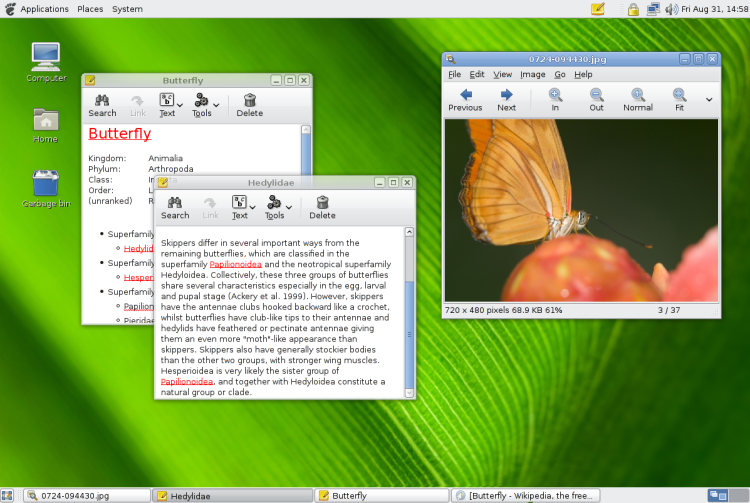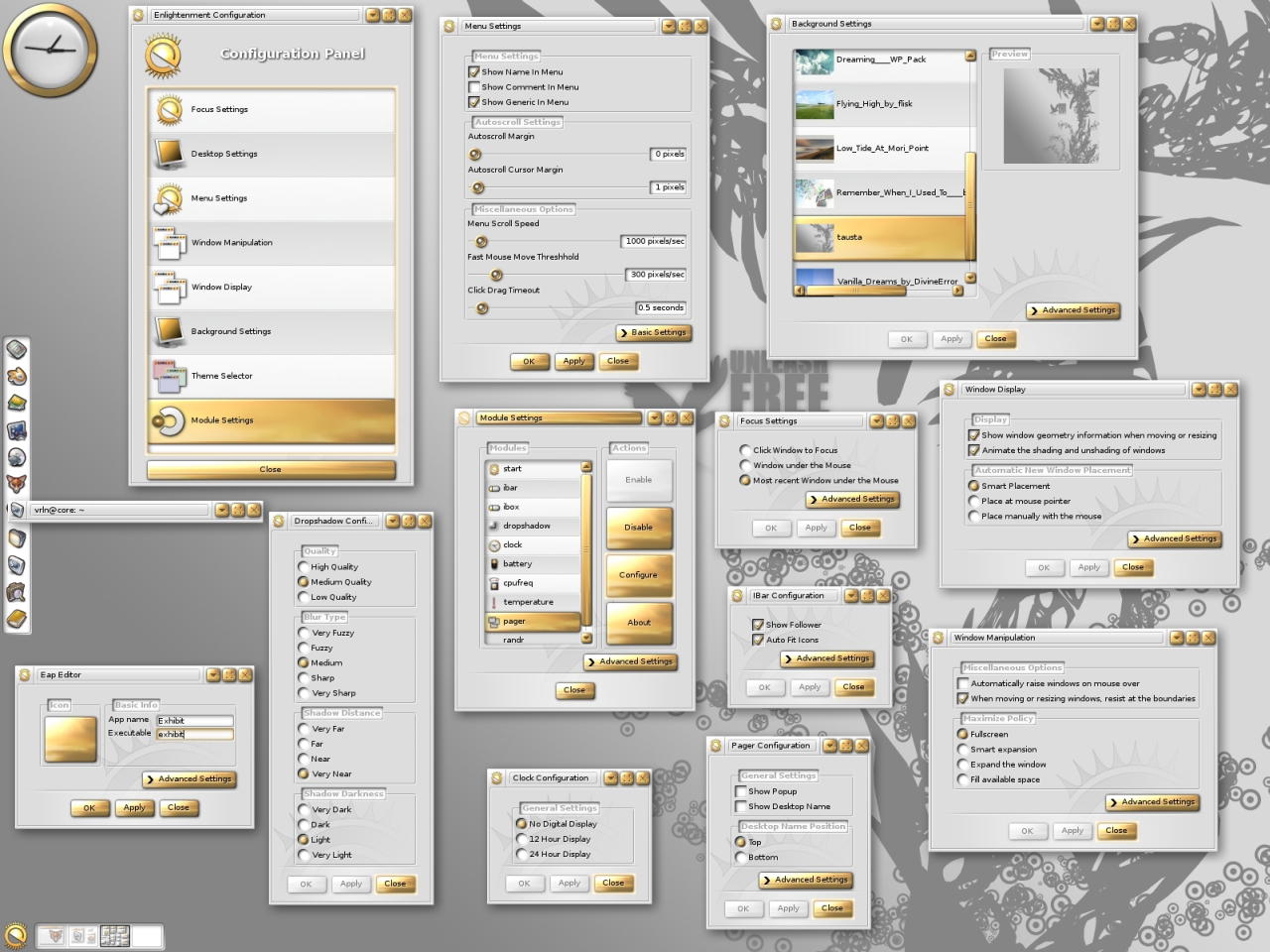|
Compositing Window Manager
A compositing window manager, or compositor, is a window manager that provides applications with an off-screen buffer for each window. The window manager composites the window buffers into an image representing the screen and writes the result into the display memory. Compositing window managers may perform additional processing on buffered windows, applying 2D and 3D animated effects such as blending, fading, scaling, rotation, duplication, bending and contortion, shuffling, blurring, redirecting applications, and translating windows into one of a number of displays and virtual desktops. Computer graphics technology allows for visual effects to be rendered in real time such as drop shadows, live previews, and complex animation. Since the screen is double buffered, it does not flicker during updates. The most commonly used compositing window managers include: * for Linux, BSD, Hurd and OpenSolaris: Compiz, KWin, Xfwm, Enlightenment, Mutter, xcompmgr and picom; ... [...More Info...] [...Related Items...] OR: [Wikipedia] [Google] [Baidu] |
Window Manager
A window manager is system software that controls the placement and appearance of windows within a windowing system in a graphical user interface. Most window managers are designed to help provide a desktop environment. They work in conjunction with the underlying graphical system that provides required functionality—support for graphics hardware, pointing devices, and a keyboard—and are often written and created using a widget toolkit. Few window managers are designed with a clear distinction between the windowing system and the window manager. Every graphical user interface based on a windows metaphor has some form of window management. In practice, the elements of this functionality vary greatly. Elements usually associated with window managers allow the user to open, close, minimize, maximize, move, resize, and keep track of running windows, including window decorators. Many window managers also come with various utilities and features such as task bars, program lau ... [...More Info...] [...Related Items...] OR: [Wikipedia] [Google] [Baidu] |
Linux
Linux ( or ) is a family of open-source Unix-like operating systems based on the Linux kernel, an operating system kernel first released on September 17, 1991, by Linus Torvalds. Linux is typically packaged as a Linux distribution, which includes the kernel and supporting system software and libraries, many of which are provided by the GNU Project. Many Linux distributions use the word "Linux" in their name, but the Free Software Foundation uses the name "GNU/Linux" to emphasize the importance of GNU software, causing some controversy. Popular Linux distributions include Debian, Fedora Linux, and Ubuntu, the latter of which itself consists of many different distributions and modifications, including Lubuntu and Xubuntu. Commercial distributions include Red Hat Enterprise Linux and SUSE Linux Enterprise. Desktop Linux distributions include a windowing system such as X11 or Wayland, and a desktop environment such as GNOME or KDE Plasma. Distributions inten ... [...More Info...] [...Related Items...] OR: [Wikipedia] [Google] [Baidu] |
Message Passing
In computer science, message passing is a technique for invoking behavior (i.e., running a program) on a computer. The invoking program sends a message to a process (which may be an actor or object) and relies on that process and its supporting infrastructure to then select and run some appropriate code. Message passing differs from conventional programming where a process, subroutine, or function is directly invoked by name. Message passing is key to some models of concurrency and object-oriented programming. Message passing is ubiquitous in modern computer software. It is used as a way for the objects that make up a program to work with each other and as a means for objects and systems running on different computers (e.g., the Internet) to interact. Message passing may be implemented by various mechanisms, including channels. Overview Message passing is a technique for invoking behavior (i.e., running a program) on a computer. In contrast to the traditional technique of ... [...More Info...] [...Related Items...] OR: [Wikipedia] [Google] [Baidu] |
Quartz Compositor
Quartz Compositor is the display server (and at the same time the compositing window manager) in macOS. It is responsible for presenting and maintaining rasterized, rendered graphics from the rest of the Core Graphics framework and other renderers in the Quartz technologies family. Overview The bitmap output from Quartz 2D, OpenGL, Core Image, QuickTime, or other process is written to a specific memory location, or ''backing store''. The Compositor then reads the data from the backing stores and assembles each into one image for the display, writing that image to the frame buffer memory of the graphics card. Quartz Compositor only accepts raster data, and is the only process that can directly access the graphics frame buffer. In managing individual windows, Quartz Compositor accepts a bitmap image of the window's contents from its renderer, along with its position. The choice of the renderer is up to the individual application, although most use Quartz 2D. Quartz Compo ... [...More Info...] [...Related Items...] OR: [Wikipedia] [Google] [Baidu] |
MacOS
macOS (; previously OS X and originally Mac OS X) is a Unix operating system developed and marketed by Apple Inc. since 2001. It is the primary operating system for Apple's Mac computers. Within the market of desktop and laptop computers it is the second most widely used desktop OS, after Microsoft Windows and ahead of ChromeOS. macOS succeeded the classic Mac OS, a Mac operating system with nine releases from 1984 to 1999. During this time, Apple cofounder Steve Jobs had left Apple and started another company, NeXT, developing the NeXTSTEP platform that would later be acquired by Apple to form the basis of macOS. The first desktop version, Mac OS X 10.0, was released in March 2001, with its first update, 10.1, arriving later that year. All releases from Mac OS X 10.5 Leopard and after are UNIX 03 certified, with an exception for OS X 10.7 Lion. Apple's other operating systems (iOS, iPadOS, watchOS, tvOS, audioOS) are derivatives of macOS. A promi ... [...More Info...] [...Related Items...] OR: [Wikipedia] [Google] [Baidu] |
Desktop Window Manager
Desktop Window Manager (DWM, previously Desktop Compositing Engine or DCE) is the compositing window manager in Microsoft Windows since Windows Vista that enables the use of hardware acceleration to render the graphical user interface of Windows. It was originally created to enable portions of the new "Windows Aero" user experience, which allowed for effects such as transparency, 3D window switching and more. It is also included with Windows Server 2008, but requires the "Desktop Experience" feature and compatible graphics drivers to be installed. Architecture The Desktop Window Manager is a compositing window manager, meaning that each program has a buffer that it writes data to; DWM then composites each program's buffer into a final image. By comparison, the stacking window manager in Windows XP and earlier (and also Windows Vista and Windows 7 with Windows Aero disabled) comprises a single display buffer to which all programs write. DWM works in different ways depending on ... [...More Info...] [...Related Items...] OR: [Wikipedia] [Google] [Baidu] |
Windows
Windows is a group of several proprietary graphical operating system families developed and marketed by Microsoft. Each family caters to a certain sector of the computing industry. For example, Windows NT for consumers, Windows Server for servers, and Windows IoT for embedded systems. Defunct Windows families include Windows 9x, Windows Mobile, and Windows Phone. The first version of Windows was released on November 20, 1985, as a graphical operating system shell for MS-DOS in response to the growing interest in graphical user interfaces (GUIs). Windows is the most popular desktop operating system in the world, with 75% market share , according to StatCounter. However, Windows is not the most used operating system when including both mobile and desktop OSes, due to Android's massive growth. , the most recent version of Windows is Windows 11 for consumer PCs and tablets, Windows 11 Enterprise for corporations, and Windows Server 2022 for servers. Genealogy By marketing r ... [...More Info...] [...Related Items...] OR: [Wikipedia] [Google] [Baidu] |
Mutter (window Manager)
Mutter is a window manager initially designed and implemented for the X Window System, but then evolved to be a Wayland compositor. It became the default window manager in GNOME 3, replacing Metacity which used GTK for rendering. Window management Mutter uses a graphics library called Clutter giving it OpenGL capability. ''Mutter'' is a portmanteau of Metacity and Clutter. Mutter can function as a standalone window manager for GNOME-like desktops, and serves as the primary window manager for the GNOME Shell, which is an integral part of GNOME 3. Mutter is extensible with plug-ins, and supports numerous visual effects. GNOME Shell is written as a plug-in to Mutter. Release history Support for HiDPI was added to version 3.13 of Mutter by Adel Gadllah. In version 3.13.2 logind integration replaced mutter-launch. In version 3.13.3 (June 24, 2014) the server side bits of wl_touch_interface were implemented by Carlos Garnacho. Forks Muffin Muffin is a fork of Mutter b ... [...More Info...] [...Related Items...] OR: [Wikipedia] [Google] [Baidu] |
Enlightenment (software)
Enlightenment, also known simply as E, is a compositing window manager for the X Window System. Since version 20, Enlightenment is also a Wayland compositor. Enlightenment developers have referred to it as "the original eye-candy window manager." Enlightenment includes functions to provide a graphical shell and can be used in conjunction with programs written for GNOME or KDE. When used together with the Enlightenment Foundation Libraries (EFL), Enlightenment can refer to an entire desktop environment. History The first version of Enlightenment was released by Rasterman ( Carsten Haitzler) in 1997. Version 0.17, also referred to as E17, was in development for 12 years starting in December 2000 until 21 December 2012 when it was officially released as stable. During the development period it was also referred to as DR17 (Development Release 17). It is a complete rewrite on DR16 and was designed to be a full-fledged desktop shell, based on the new Enlightenment Foundation L ... [...More Info...] [...Related Items...] OR: [Wikipedia] [Google] [Baidu] |
KWin
KWin is a window manager for the X Window System and a Wayland compositor. It is released as a part of KDE Plasma 5, for which it is the default window manager. KWin can also be used on its own or with other desktop environments. KWin can be configured by scripting using QML or QtScript, both of which are based on ECMAScript. History Look and feel There are many window decorations for KWin, including the current default Breeze (shown below), the previous default Oxygen, Microsoft Windows Windows is a group of several proprietary graphical operating system families developed and marketed by Microsoft. Each family caters to a certain sector of the computing industry. For example, Windows NT for consumers, Windows Server for ...-like Redmond, and Keramik. Compositing Currently available compositing backends include OpenGL 1.2, OpenGL 2.0, OpenGL 3.1 and OpenGL ES 2.0. Included effects As of KDE 4.3 the following effects are built-in: Accessibility ... [...More Info...] [...Related Items...] OR: [Wikipedia] [Google] [Baidu] |
Compiz
Compiz () is a compositing window manager for the X Window System, using 3D graphics hardware to create fast compositing desktop effects for window management. Effects, such as a minimization animation or a cube workspace, are implemented as loadable plugins. Because it conforms to the ICCCM conventions, Compiz can be used as a substitute for the default Mutter or Metacity, when using GNOME Panel, or KWin in KDE Plasma Workspaces. Internally Compiz uses the OpenGL library as the interface to the graphics hardware. Hardware requirements Initially, Compiz only worked with 3D hardware supported by Xgl. Most NVIDIA and ATI graphics cards are known to work with Compiz on Xgl. Since May 22, 2006 Compiz works on the standard X.Org Server, by using AIGLX. Besides Intel GMA graphics cards, AIGLX also supports using AMD graphics cards (including R300 and newer cards) using the open-source driver which supports since fall 2006. NVIDIA's binary drivers (since Version 1.0-9629) sup ... [...More Info...] [...Related Items...] OR: [Wikipedia] [Google] [Baidu] |

.jpg)


